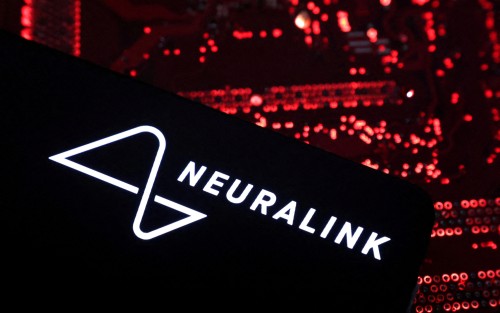By Anna Mehler Paperny
TORONTO (Reuters) – Canadian neurosurgeons in partnership with Elon Musk’s Neuralink have regulatory approval to recruit six patients with paralysis willing to have a thousand electrode contacts in their brains.
The trial, called CAN-PRIME, has started recruiting patients for a study that will test the safety and efficacy of a device that allows people to move cursors with their minds, a surgeon leading the trial said.
Neuralink announced regulator Health Canada’s approval this week. Neuralink has implanted two such devices in patients in the United States.
Directors at Neuralink reached out to Toronto-based University Health Network neurosurgeon Andres Lozano a year ago, he told Reuters. He figures his experience with other forms of brain implants played a role.
“Myself and our entire team jumped at the possibility of participating in this trial,” Lozano said.
The trial will use a two-ton robot to implant 64 electrodes, each with 16 contacts, into the hand-motor areas of patients’ brains.
The idea is that the electrodes will transmit activity in those areas so that by thinking about movement, the patient can make connected devices move.
To be eligible, individuals must have severe quadriplegia due to amyotrophic lateral sclerosis or a spinal cord injury. They would have the surgery in Toronto and use the technology at home, said Lozano, who added he hopes to start in the new year.
As the sponsor, Neuralink designed the electrodes and implantation system and will be decoding signals from the electrodes, while the doctors will be responsible for patient selection, surgery safety and health monitoring.
“The surgery obviously is a necessary crucial step, but we will not be analyzing the data or doing anything with the data. That’ll be up to the company to do that,” Lozano said.
Any procedure has risks and there is the possibility of complications, Lozano said. These include brain bleeds, infections, broken wires or wires that stop transmitting.
In May Neuralink disclosed that wires had pulled out of position in its first patient – a problem sources told Reuters the company had known about for years.
Neuralink did not respond to a request for comment. Health Canada confirmed it had issued an authorization on Nov. 15 but did not provide the study protocols.
This intervention is likely years away from being available to the general public, said Brad Wouters, executive vice president of science and research at University Health Network. But Musk “has demonstrated the ability to move quickly,” he said.
This technology focuses on reading brain activity. But there is a possibility of “writing,” too, Lozano said – of transmitting information so that, for example, visually impaired people can “see.”
But safeguards need to be in place so the technology is not abused, he added.
“There’s this issue, also, of whether the systems could be hacked and someone could insert thoughts into you or read your thoughts,” Lozano said, adding this is theoretical but “we have to put in the proper safeguards to ensure that this is done safely and properly.”
(Reporting by Anna Mehler Paperny; Editing by Caroline Stauffer and Jonathan Oatis)




